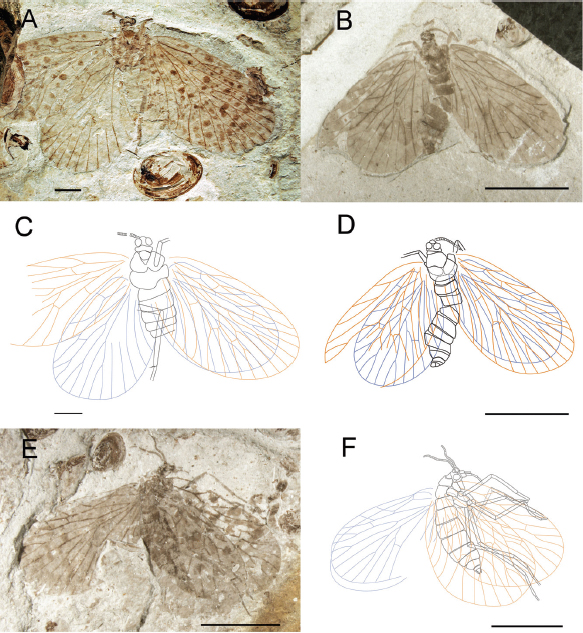The Insect Family Choristopsychidae was erected in 1937 by the Russian Palaeoentomologist Arkadiy Martynov to describe an isolated forewing from Tajikistan with distinct venation (this is not that surprising, insect wings are extremely distinctive, and palaeoentomologists are often able to make detailed predictions about the taxonomy of specimens simply from the wings). He placed it within the order Mecoptera, which includes the modern Scorpionflies, Hangingflies and Earwigflies. It has since been suggested that the specimen should be placed within the Agetoparnopidae or Permochoristidae two other groups of fossil Mecopterans.
In a paper published in the journal ZooKeys on 29 July 2013, Xiao Qiao and Chung Kun Shih of the Key Laboratory of Insect Evolution & Environmental Change at the College of Life Sciences at Capital Normal University in Beijing, Julian Petrulevičius of the División Paleozoología Invertebrados at the Museo de La Plata in Argentina and Ren Dong, also of the Key Laboratory of Insect Evolution & Environmental Change, describe a series of new specimens of Choristopsychid Insects from the Middle Jurassic Jiulongshan Formation of Daohugou Village in Inner Mongolia, which show the full anatomy of the Insects, and suggest that Martynov was correct to place them in a unique family of their own.
Qiao et al. describe ten body specimens of the species described by Martynov in 1937, Choristopsyche tenuinervis. The these are eleven mm insect preserved as part and counterpart on a limestone slabs. Both sexes are present, and the males show reproductive equipment similar to that of Scorpionflies.
Photographs and line drawings of Choristopsyche tenuinervis, gender unknown. (A) Photograph of part. (B) Photograph of counterpart. (C) Line drawing of whole specimen of part. (D) Line drawing of whole specimen of counterpart. Scale bars represent 5 mm. Qiao et al. (2013).
Further specimens of Choristopsyche tenuinervis. (A & C) Gender unknown. (B, D, E & F) Females. Qiao et al. (2013).
In addition Qiao et al. describe two new species in the genus Choristopsyche.
The first of these is Choristopsyche perfecta, which derives from 'perfectus' the Latin for complete, a reference to the fact that this species is described from body fossils, not an isolated wing. The species is described from four nearly complete specimens of both sexes, averaging 20 mm in length.
Specimens of Choristopsyche perfecta. (A) Male(?), (B) line drawing of (A), (C) sex unknown, (D) female, (E) line drawing of (C) and (F) sex unknown. Qiao et al. (2013).
The second new species of Choritopsyche is given the specific name asticta, meaning 'no spots', unlike other members of the genus this species lacks spots on its wings. This species is named from three female specimens about 20 mm in length.
Finally a fourth species is placed in a second genus. This is named Paristopsyche angelineae, where 'Paristopsyche' means 'equal soul' or 'equal mind' and 'angelineae' honours Ms. Janet Angeline. The species is described from six specimens, averaging 10 mm in length.
See also Four new species of Mantidfly from the Mesozoic of China, A new species of Scorpionfly from Baltic Amber, New Ommatid Beetles from the Mesozoic of China, Fishflies from the Middle Jurassic of Inner Mongolia and What Jurassic Katydids did.
Follow Sciency Thoughts on Facebook.
Choritopsyche asticta, (A& B) part and counterpart of first specimen, (C & D) line drawings of (A & B), (E & F) second and third specimens. Qiao et al. (2013).
Finally a fourth species is placed in a second genus. This is named Paristopsyche angelineae, where 'Paristopsyche' means 'equal soul' or 'equal mind' and 'angelineae' honours Ms. Janet Angeline. The species is described from six specimens, averaging 10 mm in length.
Paristopsyche angelineae, two specimens with line drawings. Qiao et al. (2013).
See also Four new species of Mantidfly from the Mesozoic of China, A new species of Scorpionfly from Baltic Amber, New Ommatid Beetles from the Mesozoic of China, Fishflies from the Middle Jurassic of Inner Mongolia and What Jurassic Katydids did.
Follow Sciency Thoughts on Facebook.





